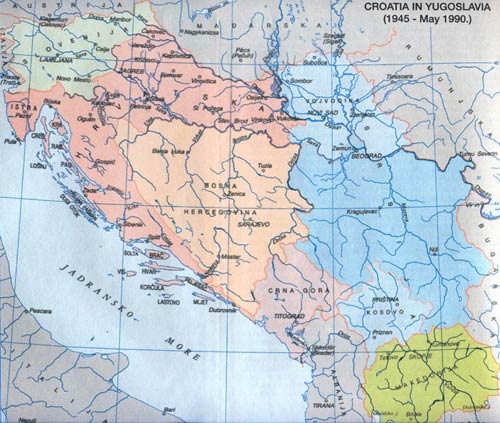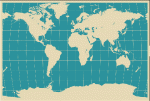Web catalog
Most read
Most read last 7 days
Most Discussed
Top rated
Statistics
- Total registered users: 10041
- Total articles: 23656
- Total comments: 2087
- Last entry: Kebo presenting evidence that Izetbegovic brought mujahideen to Bosnia
- Last update: 11.01.2019. 23:44
Communist Yugoslavia: Bosnian Chronicle (1945 - 1991)
Written 27.11.2009. 11:51
 1945 - 1991
1945 - 1991Yugoslavia as the federal communist state.
The basic characteristics of this period are:
- absolute authority of the Communist Party, especially President Tito and his subordinate inner circle
- many social, political and economical reforms ("self-menangement"), whereby they wanted to make the country functional and people "satisfied" - not questioning the ruling communist dogma
- steering a middle course after the break with Stalin's SSSR, Yugoslavia became a "ratified country" for both opposite blocks as a desirable buffer zone. Also, it became unprecedentedly involved in the international affairs, especially through the Non-alignment movement.
- development from the rigid centralism to the growing federalism and confederalism of the state in oreder to to alleviate interethnic tensions and to preserve the country in tolerably functional form. Culmination of such attempts is the 1974 Constitution.
- after the death of Tito, the absolute arbiter, the Presidency came to power. The Presidency, consisting of the representatives of all 6 republics and 2 autonomous provinces rotated the leadership every year to avoid possible ethnic/national majorization
- under the pressure of great financial obligations, old-fashioned economical and political organization as well as radicalization of the inter-ethnic/national relationships caused by the great Serbian movement, Yugoslavia fell to pieces in 1991
In that period Bosnia and Hercegovina was organized as the "triple" pyramidal structure: the privileged class, with the unquestionable domination from the police to the education and economy, were Serbs thanks to their relative numerousness, to the "merit" of suffering in NDH (yet overblown by the statistics manipulations), to the dominanace in the communist apparatus,as well as to the role of the extended hand of the Belgrade centralism of their fellow-countrymen.
On the second place were Bosnian Muslims who were supported by the Tito's supreme authority as the bearer of the "statehood" tendencies in Bosnia and Hercegovina and like the counter-balance to the Serbian and Croatian national apirations and, as the high birth-rate "Oriental" ethnos, which, paradoxically, having given up many Oriental-Islamic ways of life, was good anyway like the bridge to the Islamic countries in the Non-alignment movement. Grateful to the Communist Yugoslavia which recognized them the status of a nation, as well as brainwashed with the indoctrination by which they "succeeded" to forget their massive participation in the armed forces of NDH - Bosnian Muslims became the factor number 2.in Bosnia and Hercegovina and the staunchest followers of Yugoslav phantasm.
Croats, as the least numerous and most suspicious/"treacherous" element, were bearing the stigma of a "reactionary" Catholic nation, accused for genocide and brutality of NDH (while Muslims were "generously" exculpated, and Serbs, the main Communist executioners, were battening on the privileges of the crime) underwent the destiny of second-class citizens. Constantly under police supervision and politically persecuted,their ethnic territories intentionally economically neglected, forced to emigration (out of the economical emigrants from Bosnia and Hercegovina, Croats, who made up ca 1/5 of the population, gave over 2/3 emigrants),with the repression of the Croatian language and intruding Serbian, from the education to the massmedia - Croats were particularly the subject of the totalitarian police regime: all with the purpose of depopulation and elimination of the Croatian nation like the "carcinogenic" element, which subverted realization of the Communist totalitarian paradise on the earth.
Those were the conditions under which Bosnia and Hercegovina met Yugoslavia's final collapse.
1946
The Constitution of FNRJ (early name of Communist Yugoslavia) was brought out and according to it Yugoslavia consisted of 6 republics. One of them, Serbia, has two autonomous provinces, Vojvodina and Kosovo, within its structure.
1948
June
Yugoslav communist party was thrown out from the Cominform ( an organization of the type of Comintern, USSR-dominated with most of its members Communist Parties of the newly captured countries of Eastern and Central Europe.) Tito turned to the West, asking for financial and other help, but Yugoslavia remained a communist totalitarian country.
Bosnia and Herzegovina had 2,565,259 inhabitants, 44.29% of them Serbs, 30.73% Bosnian Muslims, 23.94% Croats and 1.04 % others.
ca 1960
Economical reforms in Yugoslavia, promoting decentralization and de-etatization, gave certain results, but they were stopped due to the nature of the communist system - if they had been carried out to the logical end,it would have meant the end of the single-party totalitarianism and the end of Yugoslavia, which rested on it.
1971
The Croatian national movement inspired by the Party's leadership of Croatian Communists broke out as a reaction to the long-lasting "creeping" Serbianization. Domination of Belgrade and Serbian mass-media, export-import firms, capital outflow from Croatia into the Eastern part of Yugoslavia, as well as the "outflow" of Croats on very often hard and low-paid work to the West - all that created critical mass of dissatisfaction with Yugoslavia, which was seen as, essentially, a Serboslavia hegemony. Under the pressure of Tito and unitarianist circles, Croatian Communist leadership capitulated. Repressions followed - about 70,000 "nationally conscious" Croatian Communists were thrown out from the Party, 2,000 were imprisoned and sentenced for various trumpeted up charges, and a few thousands of Croats were forced to emigrate.
According to the census, Bosnia and Herzegovina had 3,746,320 inhabitants. Among them 20.62% were Croats,37.19% were Serbs, 39.57% Bosnian Muslims and 2.62% others. With that census, for the first time, Bosnian Muslims got the right for the national self-identification under the name Muslims.
1972
Croatian national guerilla fighters, 19 of them, trained in Australia, organized a landing operation near central-Bosnian town Bugojno in order to rise up in arms against great-Serbian tyranny. Most of them were killed in the fight with the superior Yugoslav military and police forces, which in panic involved near 10,000 professionals and subscriptioners.
1974
The last Yugoslav Constitution, which tried to preserve the country through the confederal elements from the growing tensions and from the impending disintegration. Tito was proclaimed the President for life,and after the collective Presidency was provided, including the rotation of the members from every republic.
1980
The death of Josip Broz Tito.
1983
The trial of Alija Izetbegovic and twelve Bosnian Muslims in Sarajevo for promoting ideas of pan-Islamism and religious fundamentalism.
1987
Meteoric rise to the power of the chief of Serbian Communist Party Slobodan Milosevic. Soon he became the main organizer of the great-Serbian movement, which wanted to realize an open domination of Serbs in Yugoslavia as the police state of the extreme form, or through the redrawing of the republics borders, to destroy Yugoslavia and on the ruins to carve out great Serbia, which would include entire Bosnia and Hercegovina as well as ca 70% of Croatia. Methods were different: from the massive Fascist-like rallies, police repression, threatening with JNA, which started to transform in an open instrument of Milosevic's politics with 77% of Serbian officers staff, to the theft of federal financial reserves and unsparing mass-media war, first of all against Albanians and Croats-everything with the aim to homogenize and to use hysterical Serbian masses in Yugoslavia for great-Serbian military aggression.
1989
The Berlin Wall fell down.The end of Communism.
1990
January
SKJ (The League of Yugoslav Communists) broke down after the Slovenian Communists had walked out in protest on the Congress of SKJ,not wanting to be the subject to Miloševic's politics of centralism and Serbianization of the Yugoslav Party.
May
On the first multi-party elections after half a century, the Communists were defeated in Croatia and Slovenia. The Croatian Democratic Union(HDZ) came to rule in Croatia under the leadership of the president Franjo Tudjman,with about 60% of the votes (the percentage differed depending on various houses of the Parliament).
November
Elections in Bosnia and Hercegovina marked the end of hope of the "reformist" forces of Ante Markovic, who was still formally the Yugoslav Prime Minister and lavishly supported by the West. Reformed Communists won 6%,Markovic's Reformists 5.6% and three national parties-Muslim, Croatian and Serbian-majority: Muslim SDA 37.8%, Serbian SDS 26.5% and Croatian HDZ 14.7%. Under these conditions, the last illusion about Bosnia and Hercegovina as the "anti-nationalist" Yugoslav bastion crumbled.
1991
Out of 4,364,290 inhabitants of Bosnia and Hercegovina, Croats make 17.32%, Serbs 31.37%,Muslims 43.67% and others 7.64% of the population.
Related articles
- Early Medieval Age: Birth of a Region (c. 600 - 1180)
- Mature Medieval Period: Integration, Expansion and Dissolution (1180 - 1463)
- Ottoman Rule: Invasion, Conquest and Intermittent Warfare (1463 - 1878)
- Austro-Hungarian Rule: Tutorship and Westernization (1878 - 1918)
- Royal Yugoslavia: The Winter of Our Discontent (1918 - 1941)
- Archive of related articles
























































 Kontaktirajte nas
Kontaktirajte nas
No comments